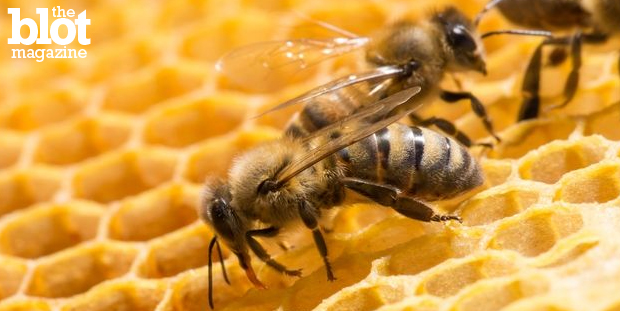My grandfather was a farmer, which means he worked his ass off. He always said it was a great job because in good years, you made money, and in bad years, you still got to eat. But the farming done in 2015 is very different from the kind he did when he started in 1915 in North Dakota. Horses pulled his plow. There were no government price-support programs. And pesticides were more or less unknown. Locusts (grasshoppers), potato beetles, caterpillar and various flies flourish in places like North Dakota, and my grandfather probably cursed them in both English and Norwegian on a regular basis for cutting into his profits.
Today, farmers can buy corn and soybean seeds coated with neonicotinoids, a group of chemicals that kill these insects that can devastate a field. The problem is that they don’t seem to be very targeted on the bad bugs. There is a growing body of evidence that they will kill bees as well as flies.
Well, who gives a good goddam? Honey is over-rated as a food, and the little bastards sting.
As it turns out, bees are responsible for a huge amount of plant pollination. Without bees to do this job, crop yields would plummet, which would mean mass starvation. Of the top 100 crop species, bees pollinate 70. Honey bees account for $30 billion in crops every year. While Einstein probably never said, “If the bee disappeared off the surface of the globe then man would only have four years of life left,” it would suck if they were gone.
Colony Collapse Disorder [CCD] is a phenomenon in which an entire colony of bees suddenly dies off, and its becoming widespread, and a study at Harvard (the University of North Dakota of the east, but lacking the same ice hockey talent), stated, “We demonstrated again in this study that neonicotinoids are highly likely to be responsible for triggering CCD in honey bee hives that were healthy prior to the arrival of winter.”
Of course, there are voices out there that say this is all bull. The Genetic Literacy Project [GLP] says so. Apparently, the debate is not settled — until you look at who funds the GLP and who works there. If any of this is untrue, the GLP should have sued. It hasn’t.
Read more: According to NASA’s Climate Predictions, We’re Screwed
I am old enough to remember how the Tobacco Institute fought the idea that smoking tobacco was unhealthy. We are all living with the idiocy of climate change denial. Seems to me that this is more of the same.
Seems like it to the government of Ontario, Canada, too. In the winter of 2013-14, 58 percent of the honey bees there died. So, as of July 1, 2015, new rules apply. The Toronto Star reports, “For next year’s planting season, farmers will be allowed to use the seeds on up to 50 per cent (sic) of their corn and soybean fields with exceptions being granted only to those who can provide evidence of pest problems.
“In 2017, all farmers wanting to use any neonicotinoid-treated seeds will have to prove they have pests.”
I am not an etymologist, so I won’t pretend to know the answer to the neo-nic link to CCD. What I can prove, though, is that bees are pretty sensitive to the stuff in their environment — I cite the case of blue honey in France.
In the town of Ribeauville in the Alsace region of France, bees started producing blue honey in 2012. Needless to say, this was a surprise that warranted investigation. It turns out “a biogas plant 4 km (2.5 miles) away has been processing waste from a Mars plant producing M&M’s, bite-sized candies in bright red, blue, green, yellow and brown shells.” The bees had been feeding on the shells. The result was blue honey.
If feeding on M&Ms can make bees produce blue honey, it isn’t hard to believe that feeding on pesticide-treated crops might be bad for them. I am not saying it is so. I am saying that the burden of proof seems to lie with those producing the neonicotinoid-laced seeds.
Jeff Myhre is a contributing journalist for TheBlot Magazine.






